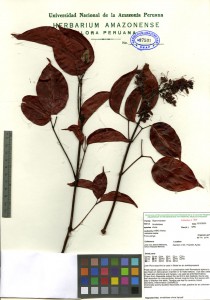Amazonian Digital Herbarium Project
This is a big project, with far-reaching implications. An herbarium is the facility that holds the official collection of pressed plant specimens of a region. Each plant is pressed, dried and mounted to make an herbarium specimen. BD’s Peruvian partner in this work is the Herbarium Amazonense (AMAZ), in Iquitos, Peru. This facility is maintained under UNAP (Autonomous University of the Peruvian Amazon). Botanists from all over the world have come to the Amazon to study the flora there, and have deposited herbarium specimens of their own collections at AMAZ. We are grateful to the staff there for sharing the vision, and collaborating with BD on this project.
Our project’s goals are:
1) Assist the AMAZ Herbarium in improving the order, accuracy and care of their remarkable collection.
2) Digitally scan the pressed specimens of every species in the AMAZ collection, for the sake of both preservation and education. In this effort, we join many important institutions that are already involved in creating a global biodiversity information management system.
3) Create an information-packed, image-rich database that includes the reported folk uses of these species, linked to published research on the species’ chemistry and pharmacology, whenever relevant.
We hope that by preserving and highlighting the potential of food and medicine species in particular, we might promote sustainability and preservation of Amazonian species and habitat. Our database will be in English to begin with, but we hope to translate it to Spanish in the next stage, and to cite articles published in Spanish too. We intend to make this database public and at least affordable, if not free.
BD received a generous grant in 2010, from the Promega Corp. This 3-year donation is designated specifically to support the AMAZ herbarium, gather data that include the chemistry, pharmacology and ethnobotany relevant to each species that we catalog, and then create a public database of these images and information. We are currently seeking funding to keep this project going beyond 2013. There is much more valuable information to be added, as well as ongoing costs of development and maintenance of the database. (Even smaller designated contributions are helpful.)
As project director of the Digital Herbarium Project, Kathleen Harrison works with botanists Juan Ruiz Maceda and Arturo Vasquez, in Iquitos, Peru. We commit our effort—mounting and scanning an existing herbarium collection, then expanding this taxonomy-based digital herbarium to include Amazonian folk knowledge and known pharmacology—to the future of plant-derived medicines and useful compounds, and public education about them. Following the long-standing principle of BD, we take each step with respectful acknowledgement of indigenous people, their intellectual property, and the environmental needs of the source of these plant species.
In the U.S., we are linking the scans with published information about each of the species, to give as full a profile as possible about the Upper Amazon’s botanical resources. In the database that we are developing, we link each specimen with ethnobotanical, pharmacological and chemical information about that species. BD is collaborating with NAPRALERT (Natural Products Alert Database, where Dr. James Graham has been most helpful: See napralert.org), as well as with other sources. Gauss Rescigno is developing the database, and Dr. Dennis McKenna has advised the project.
Our hope is that by making this information available in a database combining so many important elements we will:
~ Encourage respect for the human and natural resources there through education
~ Foster preservation of the habitat that supports these species and knowledgeable peoples
~ Direct interest toward plant medicine, foods, and natural products that might be grown and harvested through careful management and cultivation (by using sustainable agro-forestry techniques in the Amazon)
~ Improve the connectivity between humans, plants and their habitats
